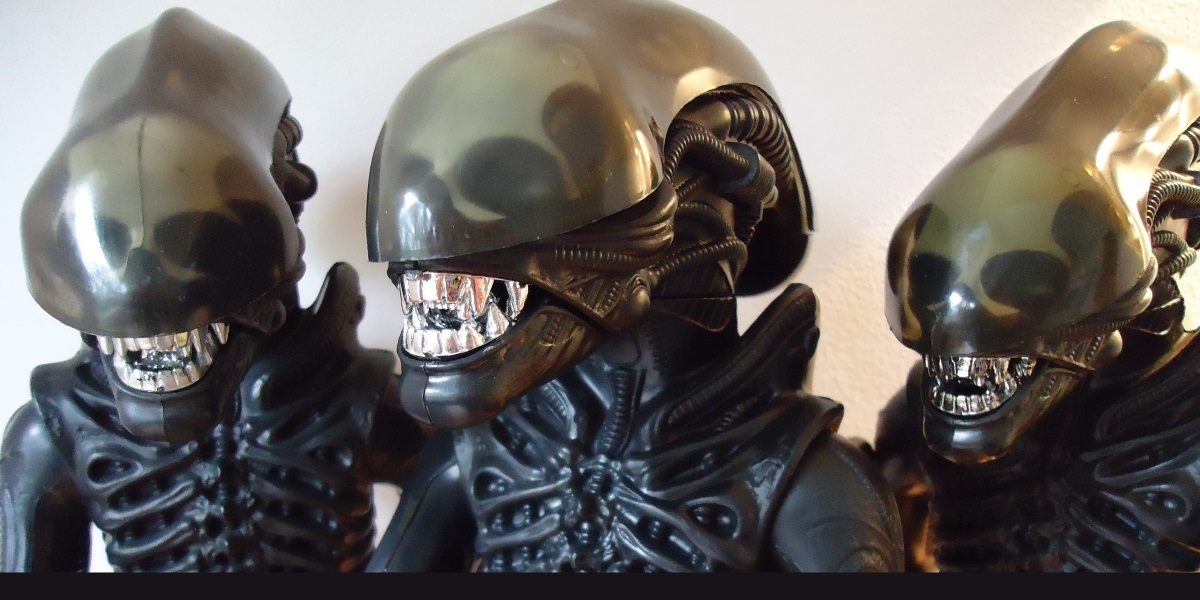
You have a decent number of options when it comes to addressing any damaged part on the Kenner ALIEN figure. (1.) You can ignore it – it won’t change anything, but it’s still an option. (2.) You can disassemble the figure and replace any part with a better quality one purchased online. Or (3.) you can repair the part in question and re-attach it. In this case, let’s look at Option 3 for dealing with this seriously damaged right leg.
You can see in the image below, the leg is completely out of alignment on the figure. Aside from the clearly undesirable appearance, the poor condition of the hip joint is providing absolute minimal support giving the figure a tendency to fall over. A lot. We can fix this failing limb. We won’t glue it in place, though, that will completely remove all articulation. We don’t want to do that. Instead, it will be completely rebuilt with the goal making it fully functional once again.

The first step is to clear away any remains of the damaged spindle and flange that is still present. We need to start from scratch to rebuild this point of attachment if we want the figure to stand upright and have full 360 degree rotation returned to it. To do so, we need to strip it all back.
The tortured remnants of the old spindle and flange will have to go. That’s not a problem as what remains is already showing signs of falling off. We just need to urge it with a little encouragement using a pair of pliers to gently remove it without any further tearing.

Here is the leg with those remains removed.The rough surfaces have also been sanded back. It will need to fit flush with the corresponding surface on the torso, so this surface needs to be flat before we commence the next stage. Despite the obvious damage, it’s easier to start with a clean slate rather than rebuild the old spindle and flange as it was.

Now the surface is clear and tidy, we can start rebuilding the joint. We’ll need a few materials to do so: Filler & catalyst, 3x short screws, glue and an old DVD case. The tools required will be: Some sand paper, a drill, a screwdriver and leather hole punch. Not much, is required, really.
Now that we are at the stage of rebuilding this joint, let’s get started. Filler and catalyst is mixed to fill the vacant space we see. When applying it, I’m making sure it is spread around inside the upper thigh so it contacts with as many internal surfaces as possible. The more filler added, the stronger the joint will be. No. I don’t need to fill the whole leg – but I do make sure enough filler is contacting around the thick post inside the leg that holds both halves in together. That will definitely strengthen the foundation.
I use a brand of filler that will set and have properties similar to wood. It is forgivingly versatile and able to be easily sanded back, drilled and have screws placed into it without fracturing or cracking the hardened material. Here’s the result of filling in the gap.

I have to wait until the filler is set. Times can vary and it’s usually set in an hour or 2. Maybe a little longer depending on the filler used. Once hardened and ready, any excess filler and high spots are sanded back to make the leg surface flush once again. Remember, this surface has to sit on the matching one on the torso so it must be flat. Once this stage is completed, we now have a perfect foundation to re-construct the new spindle and flange necessary to reattach the leg to the figure.

It’s time to move onto the next stage of finishing this leg and for that, we will need to rebuild the spindle and flange. That task shall be addressed on the next page.
Now, where did I put that old DVD case..?
-Windebieste.
Part 1: Introduction.
Part 2: Assessment and Evaluation(1 of 2).
Part 3: Assessment and Evaluation (2 of 2).
Part 4: Disassembly and Cleaning.
Part 5: Loose Hip Joint Repair.
Part 6: Broken/Destroyed Hip Joint Repair (1 of 2).
Part 7: Broken/Destroyed Hip Joint Repair (2 of 2).
Part 8: Severed Arm Repair.
Part 9: Damaged Shoulder Repair.
Part 10: Improvised Replacement Arm.
Part 11: Final Assembly.

